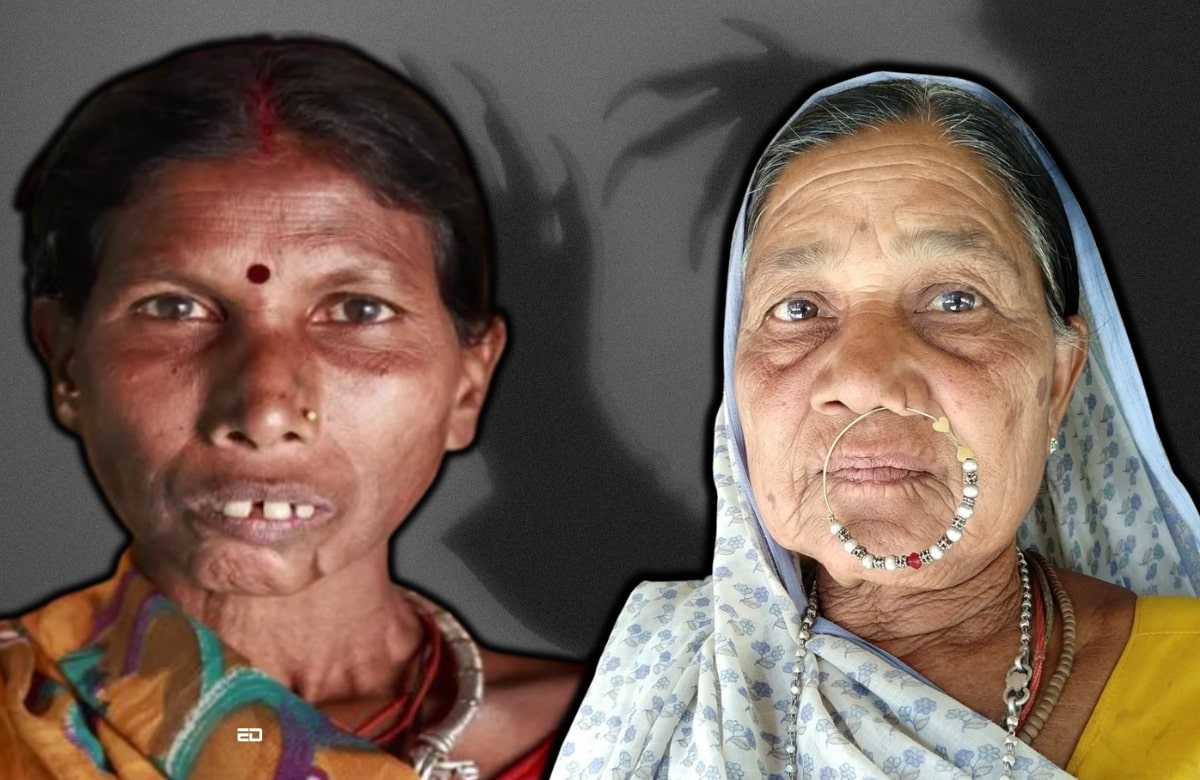In the heart of Jharkhand, a state marked by both mineral wealth and widespread poverty, the ancient practice of witch hunting persists, taking a deadly toll on women who are often accused without evidence.
Beyond the veil of superstition, a darker motive emerges—one that targets women who dare to challenge societal norms. This comprehensive exploration delves into the tragic events of a night in 2015 when five women were brutally hacked to death in Kanjiya Maraitoli village, bringing to light the complex layers of witch hunts in India.
The Night of Horror
The chilling night of August 8, 2015, witnessed the brutal killing of Jasinta, Madani, Titri, Rakiya, and Eitwariya in Kanjiya Maraitoli village, situated a mere 30 kilometers from Ranchi, the state capital.
Accused of witchcraft, these women fell victim to a mob of relatives and neighbors who, driven by superstition and potentially other motives, subjected them to a fatal assault. The victims’ crime was multifaceted—they were not just victims of baseless beliefs but were actively involved in advocating against alcohol consumption and promoting education, challenging the status quo in their male-dominated society.
Motives Beyond Superstition
While accusations of witchcraft have traditionally been rooted in superstition, the Kanjiya Maraitoli case reveals a more sinister layer. The women targeted were not just victims of baseless beliefs but were actively involved in advocating for education and opposing alcohol abuse.
Their outspoken nature, particularly against societal norms, made them targets in a community unwilling to accept change. The killings, it appears, were not solely fueled by superstition but also by resistance against these women’s efforts to bring about social transformation.
The Aftermath and Legal Response
Following the gruesome events, an FIR was filed against 150 individuals, but shockingly, they were later released on bail. This highlights a severe flaw in the legal system’s ability to effectively intervene and deliver justice.
Despite efforts like Project Garima, a state-run program in Jharkhand aimed at preventing witch-hunting, the persistence of entrenched beliefs and weak law enforcement contribute to the ongoing tragedy.
National Scale of Witch Hunts
Witch hunts are not confined to Jharkhand alone; they persist in nearly a dozen Indian states, predominantly in tribal areas. From 2010 to 2021, over 1,500 people were killed in India after being accused of witchcraft.
The reasons behind these accusations are diverse, ranging from settling scores to justifying violence, land grabbing, or ostracizing women. This alarming trend underscores the urgent need for a nationwide strategy to address the root causes of witch hunts.
The Plight of Survivors
Survivors of witch hunts endure not only physical trauma but also face social ostracization. Labeled as witches, they are barred from communal resources, blamed for various misfortunes, and left in isolation.
The consequences extend beyond the physical assault, impacting the psychological and economic well-being of the victims. Durga Mahato’s case exemplifies the broader struggle faced by survivors, as she not only battles physical pain but also contends with the stigma attached to being labeled a witch.
Challenges in Eradicating Witch Hunts
Despite legislative efforts and awareness campaigns, the practice of witch hunting persists. Law enforcement often intervenes only in cases of murder or attempted murder, leaving room for continued persecution.
Changing entrenched beliefs remains a significant challenge, requiring a multifaceted approach that combines legal measures, education, and community awareness. The deeply ingrained nature of these practices calls for sustained efforts to challenge and transform cultural norms.
Efforts in Jharkhand and Beyond
Jharkhand, a mineral-rich yet poverty-riddled state with a quarter of its population comprising Indigenous tribes, has taken steps to tackle witch hunts. Project Garima, a state-run initiative, has deployed “witch-hunting prevention campaign teams” to raise awareness through street plays.
Village-level protection committees aid survivors, and centers provide legal aid and short-stay arrangements. However, challenges persist, and the state’s 2023 target for eradicating witch hunting has been pushed back, reflecting the difficulties in achieving this ambitious goal.
In Ms. Mahato’s case, the most helpful assistance came not from the government but from another witch-hunt victim, Chhutni Mahato, who has been recognized by the Indian government for her work in trying to eliminate the practice.
Durga Mahato’s case brings to light the importance of community support. While state initiatives are crucial, survivors often find solace in the empathy and understanding of those who have experienced similar horrors. Chhutni Mahato’s efforts, recognized by the Indian government, demonstrate the impact that grassroots movements can have in combating witch hunts.
Chhutni Mahato’s broken teeth are testimony to the torture she once bore at the hands of villagers who blamed her for a girl’s illness. She ran away and years later began working with a nongovernmental organization.
Chhutni Mahato’s journey from being a victim to an activist exemplifies resilience and the power of individuals to drive change. Her broken teeth bear witness to the physical brutality she endured, but her subsequent dedication to working with a non-governmental organization highlights the potential for survivors to become advocates against witch hunts.
Read More: Beer Industry And Its Origin That Connects To Women And Witches
Community Empowerment and Survivor Stories
Survivors like Chhutni Mahato play a pivotal role in challenging the prevailing mindset and dismantling the structures that perpetuate witch hunts. By actively engaging with law enforcement, demanding action on witch-hunt cases, and scolding village heads over the phone, Chhutni exemplifies the potential for change from within the community.
Her ability to inspire trust among victims is crucial, as survivors often reach out to her through word of mouth, seeking assistance and guidance.
Durga Mahato’s aunt had heard about the work of Chhutni Mahato (the two women are not related). Durga found refuge for weeks in Chhutni’s mud-and-tile-roofed home after spending two weeks in the hospital.
The story of Durga Mahato finding refuge in Chhutni Mahato’s home highlights the importance of safe spaces for survivors.
Beyond legal and governmental interventions, the creation of support networks and shelters is crucial for survivors to rebuild their lives. Chhutni Mahato’s humble mud-and-tile-roofed home becomes a symbol of sanctuary and solidarity for those seeking refuge from the aftermath of witch hunts.
Continued Challenges and the Role of Law Enforcement
While initiatives like Project Garima are essential in raising awareness and preventing future atrocities, the broader challenge of changing ingrained beliefs and dismantling patriarchal structures requires sustained, nationwide efforts.
Law enforcement, as demonstrated in the Kanjiya Maraitoli case, often intervenes only in cases of murder or attempted murder, leaving room for continued persecution and harassment of women labeled as witches. The reluctance or inability of the police to address the issue comprehensively hampers progress in eradicating this practice.
In Ms. Majhi’s case, suspicion fell on her simply because she did not conform to neighbors’ expectations. Villagers wondered how a “normal woman” could live by herself with her young children, deep in the forest, while her husband was away for work. Then they labeled her a witch.
The case of Dukhu Majhi underscores the arbitrary nature of accusations, where individuals who deviate from societal expectations become targets. The deeply entrenched gender norms and rigid expectations imposed on women contribute to the perpetuation of witch hunts. Addressing these underlying issues requires not only legal reforms but also a broader societal shift in attitudes towards women and their autonomy.
The Way Forward
Efforts to eradicate witch hunts must extend beyond legal measures and include comprehensive strategies that address the root causes. Education plays a pivotal role in challenging superstitions and fostering a more inclusive and enlightened society.
Initiatives like Project Garima should be strengthened, with a focus on education that promotes gender equality, challenges traditional norms, and encourages critical thinking.
Moreover, awareness campaigns should highlight the positive contributions of women targeted by witch hunts, emphasizing their roles as community leaders, advocates for education, and voices against social vices like alcohol abuse. By reshaping the narrative surrounding these women, communities can begin to recognize the value they bring rather than succumb to baseless accusations.
In addition to legal reforms, the government and non-governmental organizations should work collaboratively to provide psychosocial support, rehabilitation, and economic opportunities for survivors. Creating networks of support, led by individuals like Chhutni Mahato, can provide crucial emotional assistance to those who have endured trauma.
The tragic events in Kanjiya Maraitoli village serve as a stark reminder of the deeply rooted challenges India faces in eradicating witch hunts.
Beyond mere superstition, the persecution of women advocating for change underscores the urgent need for comprehensive efforts to address the social, economic, and cultural factors that fuel such practices. Until then, the victims continue to endure not only the horrors of violence but also the haunting specter of societal discrimination.
Efforts like Project Garima in Jharkhand are essential steps toward raising awareness and preventing future atrocities. However, the broader challenge of changing ingrained beliefs and dismantling patriarchal structures requires sustained, nationwide efforts.
As the nation grapples with the complexities of witch hunts, it is crucial to amplify the voices of survivors, acknowledge the role of gender dynamics, and foster an environment that empowers women rather than persecutes them.
The fight against witch-hunting is not just a legal battle but a societal transformation that demands collective action and a commitment to justice and equality. Only through a holistic approach can India hope to eradicate this deeply entrenched menace and pave the way for a future where no woman lives in fear of being labeled a witch.
Image Credits: Google Images
Feature image designed by Saudamini Seth
Sources: The Quint, Deccan Herald, The New York Times
Find the blogger: Pragya Damani
This post is tagged under: Witch Hunts, Gender Dynamics, Superstition, Women’s Rights, Jharkhand, India, Social Change, Community Empowerment, Project Garima, Legal Reforms, Survivor Stories, Grassroots Movements, Cultural Transformation, Patriarchal Structures, Human Rights, Indigenous Tribes, Awareness Campaigns, Education, Stigma, Socioeconomic Impact, Law Enforcement, Non-Governmental Organizations, Psychosocial Support, Rehabilitation, Empowerment, Equality
Disclaimer: We do not hold any right, copyright over any of the images used, these have been taken from Google. In case of credits or removal, the owner may kindly mail us.
































